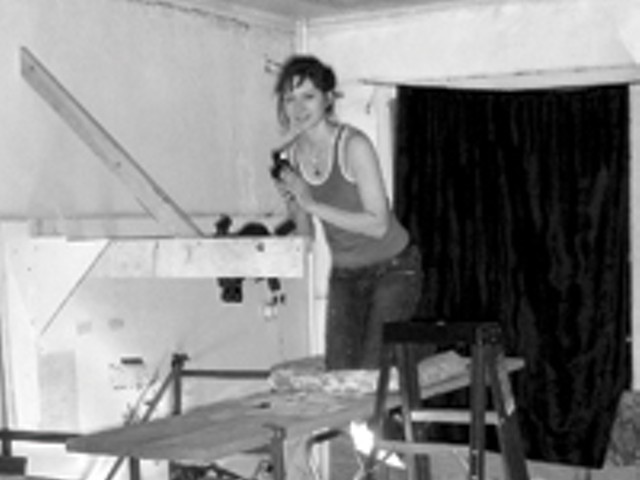A flagrant theatricality unites the two series of paintings in Brenda Goodman's new show at Paul Kotula Projects in Ferndale. Together they suggest that the celebrated Cass Corridor artist — who retains a cult-like following here despite having lived in New York since 1976 — has fled the studio to join the circus, or to make silent films.
In Brenda Goodman: New Work, she takes on multiple roles: creative director, set designer, ringmaster, daredevil performer and itinerant songstress. Viewers willing to join in the fun will be entertained aesthetically, psychologically and philosophically.
"Songs," the earlier series, exults in Goodman's finally learning to sing despite her deafness in one ear. Six "Song" paintings depict Goodman vocalizing in a variety of personas. Always seeking beauty, to represent sound she chose to use bright yellow paint in thin, wavy lines, engagingly raised on the surface. Distant evaporating sound is indicated by delicate rococo dabs and flourishes in the same color.
The narrative of Goldilocks sampling porridges is useful in describing three of the "Song" pieces: In "Longing," a primly seated woman, hands positioned politely in her lap, her head bent slightly backward and mouth open, sings softly and sweetly. Too cold. In "Heart Song," a hideous bald-headed being with an oversized neck, huge orange lips and gnarled gray hands, sings soulfully and operatically of loneliness. Too hot.
But "Night Song" is just right! A charming Watteau-inspired Pierrot figure, silhouetted against a black sky, sings romantic music for lovers, through perfect red lips. Oodles of superimposed yellow lines indicate a long enchanted night filled with music.
Two landscapes situated in the Catskills demonstrate Goodman's mastery of painting techniques. Though the singer is portrayed in both as singing out-of-doors, the contrast in paint application indicates different psychological states. One is soothing with gentle hypnotic colors, especially in the sky and mountains, and a smooth surface. The other alarms with violent brushstrokes and angry slashes of poisonous color. Goodman turns a pleasant scene into a horror film: she, and her little dog too, appear on the verge of melting like the Wicked Witch of the West.
The second series is unnamed, its works merely numbered. A commonality between them, important to the coherence of this elegantly installed exhibition, lies in their performative natures. "Song" exults. The untitled works inspire edge-of-your-seat anxiety. They read as Goodman's own "Perils of Pauline" — early silent-film cliffhangers — and also as physical feats of circus-like derring-do. Goodman stars as the heroine, costumed as a minute, generic human. She dangles either from high tightropes or teeters on very tall seesaws, depicted precisely at the moment of imminent action. In No.14, she stands at the bottom of a giant slide as large black boulders descend to crush her.
Goodman's strength is as set designer. Because the figures are so small, the psychological dramas aren't discernible from a distance. The eye is instead captivated by the crisp graphic power, bold colors and strong diagonals of the compositions. Vibrant red shapes, such as in No. 6, stand out. The stages themselves — with a nod to Cézanne — are complex intriguing constructions; unintelligible spaces willed together from misaligned planes. In two works, Goodman incorporates replicas of her early "box" sculptures — small, bleak proscenium "stages" peopled with odd creatures that were exhibited in the 1979 Whitney Biennial.
Nos. 5 and 6 include what look like piles of chopsticks or kindling but are actually the edges of stacked-together paintings. Ominous red shapes hover near the paintings, dripping red or black goo. These nestle below, while high above performers dangle by one arm or balance precariously on spindly tall teeter-totters.
What interpretations should be squeezed out of these enigmatic works? Apart from their formal strength and entertaining drama, do they engage the mind? Kotula admits that frustrated viewers "get caught in stories that never get finished." Yet the viewer may provide her own ending. Here is a clue from Goodman, however: In each perilous scene she has provided a way out: openings provide exits and give her, and us, the opportunity to counter despair with hope, bondage with freedom.
Brenda Goodman: New Work is on display at Paul Kotula Projects through April 5; 23255 Woodward Ave., Ferndale; 248-544-3020.
Christina Hill writes about art for Metro Times. Send comments to [email protected]




